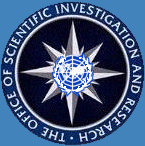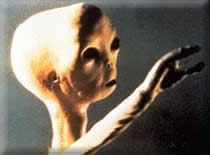Inflation - Theory Implications for Extraterrestrial Visitation
(Part 2 | <--)
5. Re-Evaluation of the Phenomenon Needed 5.1 Sightings Since the Condon Report
 The self-inconsistency of the Condon Report, along with the The self-inconsistency of the Condon Report, along with the
strengthening of Fermi's paradox through recent developments in
cosmology, physics, astronomy and astrobiology, are but two reasons to reevaluate the UFO phenomenon. Another reason is that remarkable sightings did not cease with the publication of the Condon Report in 1969. Many detailed sightings since then have become available for examination. Scientists should not feel reluctant to study these inasmuch as the Report's executive summary stated that 'any scientist with adequate training and credentials who does come up with a clearly defined, specific proposal for study [of UFO reports] should be supported.'
One example of sightings worth studying are those that occurred
on December 31, 1978 off the northeast coast of South Island,
New Zealand. These involved several channels of information
recorded on tape and film during the sightings, correlated
visual air- and ground-radar detections and light phenomena
recorded on colour movie film as well as reports by the eight
witnesses who were involved. Analysis of the recorded data and
of the witness testimony indicates that unknown objects emitting
bright light were detected on radar, filmed and apparently moved
in response to the motions of the airplane carrying the
witnesses. The sightings have defied all mundane explanations
[31-32].
Some investigations of unexplainable sightings have been
sponsored by governments outside the U.S. Since 1977 the French
Space Agency has carried out an official investigation of UFO
reports with its project GEPAN, later called SEPRA. In the
Belgium sighting wave of 1989-90, civilian and military
officials cooperated in sharing eyewitness, radar and video-
image data of triangular-shaped craft.
5.2 Withheld Information Now Available
 The Condon investigators did not have full access to the information and analysis compiled previously by the U.S. Air Force Office of Intelligence (AFOIN) or to all the information collected by Project Blue Book. The Condon investigators did not have full access to the information and analysis compiled previously by the U.S. Air Force Office of Intelligence (AFOIN) or to all the information collected by Project Blue Book.
Much of this information has been disclosed in the years since 1968. The information release has come about on five fronts.
First, the U.S. Air Force released the complete files of Project Blue Book in 1975. This release included the previously unavailable files of the Air Force Office of Special Investigation (AFOSI). Second, the U.S. Freedom of Information Act, which went into
effect in the mid 1970s, resulted in the release of relevant
information from other agencies (Federal Bureau of
Investigation: FBI, in 1977; Central Intelligence Agency: CIA,
in 1978; etc.), though often in a censored form [23-24].
A third new source of information is the collection of
previously withheld reports and analyses carried out by the
AFOIN in the late 1940s and early 1950s. This information has
been released in the last 20 years as a result of standard
declassification requirements for old documents. It shows that
Air Force intelligence privately concluded that as many as 5% of
the sightings were unexplainable even though they were
apparently accurate reports made by credible observers, thus
contradicting the public statements of the Air Force that all
sightings could be explained. The documents provide an
explanation as to why Air Force intelligence told the FBI in
August and again in October, 1952, that some top Air Force
officials were seriously considering the 'interplanetary'
explanation [33].
Fourth, governments of countries other than the United States,
over the last 25 years, have released relevant information
collected by their armed services and police. Not only has the
French government, through GEPAN and SEPRA, released sighting
documents but also England's Ministry of Defense recently
released a number of documents. The governments of Spain and
Canada also released documents in the 1970s and 1980s. Moreover,
some governments besides that of France have official
investigative groups on this topic. In 1997, in response to
civilian and military sightings over the previous years, the
Chilean Air Force formed the Committee for the Study of
Anomalous Phenomena (acronym, CEFAA in Spanish) directed by a
former Air Force general and headquartered in the Technical
School of Aeronautics in Santiago. One of us (Maccabee) was
invited to Chile in 1999 to lecture at a symposium sponsored by
the CEFAA and to discuss the sightings. The Peruvian Air Force
set up a similar group in 2001. Brazil and Uruguay also have
comparable investigative groups.
A fifth new source of information not available or utilised by
the Condon group consists of the many witnesses to events in the
1940-1960 decades who had worked for the government or the
military and after reaching retirement age, have come forward to
divulge their first-hand knowledge [34]. They have felt it was
more important for the citizens to know what has been taking
place than to continue to obey instructions to maintain silence
about it. A reluctance to report UFO events arose because of a
curtain of ridicule which, since the 1950s, had settled over the
subject. It was induced in part by the CIA's 1953 Robertson
panel that recommended a debunking programme against the reality
of the phenomenon [20,22-23].
The debunking is most often implemented by an authority figure
asserting, at his own volition and without interviewing the
witnesses, that whatever was observed and reported as
extraordinary was instead the misidentification of something
mundane. This is demeaning to sincere, credible witnesses. The
major news media quickly picked up on sarcastic phrases like
'little green men' and 'UFO buffs', then gradually weaned
themselves away from the topic=97reporters, editors and corporate
owners fear ridicule, whether just or unjust, as much as do
scientists and politicians. The refusal of the U.S. Air Force in
the 1950s and 1960s to release sighting data it had collected
only added to the problem, since evidence collected by the
government was not available to support the witnesses [33].
The first director of the CIA assessed the situation in 1960 as
follows: 'Behind the scenes, highranking Air Force officers are
soberly concerned about UFOs. But, through official secrecy and
ridicule, many citizens are led to believe the unknown flying
objects are nonsense=85 to hide the facts, the Air Force has
silenced its personnel' [35]. The Condon Report also added to
the problem, since it demonstrated that men of science could
simply allege that witnesses are mistaken or dishonest and they
would be believed by most of their colleagues even though they
had no evidence to back up their allegations. This in turn led
to greater reluctance on the part of witnesses to come forward.
As a result, 'the most credible UFO witnesses are often those
most reluctant to come forward with a report of the event they
have witnessed' [27]. This ridicule factor has prevented many
serious investigators from even attempting to report their
findings within the journals preferred by most scientists.
Therefore, one of the recommendations made by the moderator of a
1997 panel of scientists is that journal editors should change
their policy of refusing to even seriously consider publishing
articles related to the UFO phenomenon, so that this difficulty
may be alleviated [36].
6. Inferring an ET Strategy
 If one allows that at least some unexplainable sightings may be manifestations of extraterrestrial intelligence, then there is yet another reason for reevaluation: a growing recognition over If one allows that at least some unexplainable sightings may be manifestations of extraterrestrial intelligence, then there is yet another reason for reevaluation: a growing recognition over
the past two decades that a large part of the behavior manifested can be viewed as being quite rational. The topic of ET behavior has received considerable discussion in connection with SETI in the past three decades. SETI has proceeded on the
assumption that Fermi's paradox is to be solved through continued and enhanced searching of the sky for electromagnetic signals indicative of ET communications [37]. Several possible reasons for lack of success to date have been proposed [1,37-
38].
Since the 1970s advocates of a covert ET presence in our
vicinity have also been advancing their hypotheses or scenarios.
They reject as improbable the assumption that space-faring ETs
must be dominated by the most evil and aggressive of their kind=97
an assumption whose consequence would be that we should not be
existing as a freely developing civilisation within a fully
colonised and/or explored galaxy. Contact optimists instead
presume that many advanced ET groups are at least as ethical as
we are, while still attending to their own safety and security.
The ET motivation for space travel could be to increase their
knowledge through exploration of space rather than to colonise
and seek domination [39]. Thus hypotheses have been set forth
regarding why such ETs would be aware of our presence but not
yet have contacted us overtly. Among these are the zoo, nursery
and quarantine or embargo hypotheses [1,38,40-42]. Most of these
posit that the ETs involved have frequently scouted us out semi-
covertly and have concluded that we are either not yet mature
enough for open contact, or not prepared for it, since any
abrupt, overt contact could cause societal chaos and
governmental downfalls. Also postulated is that ET interference
with our society would prematurely bring an end to our
civilisation's continued development if it occurred before our
knowledge has progressed to the point that we could understand
where the aliens could have originated and how great their head
start over us could be [39].
A serious inconsistency in this reasoning, however, is that
maintenance of total ET covertness towards Earth and the solar
system would still lead to societal chaos whenever the
covertness or embargo was eventually lifted, unless the ETs
carried out a programme of gradual disclosure=97a 'leaky' embargo
[1,43]. Although the zoo or embargo hypothesis may be
unverifiable, the leaky-embargo hypothesis may be verifiable if
the UFO evidence is taken into account. Much of this evidence
appears to constitute just such a leak in the embargo: a grass-
roots educational programme in the form of the phenomenon, which
has been in operation since 1947, if not before.
Many sightings have been of a nature to attract attention to
their craft and let isolated groups of witnesses know that its
occupants are aware of us [24,44]. A key category of such cases
involves reports wherein persons within a traveling vehicle
frantically witness an object pacing them even though their
automobile or aircraft makes turns that rule out the sighting of
an astronomical or other ordinary object as any explanation.
Similarly, in a number of the aircraft cases the unknown object,
which was either pacing the aircraft or presenting itself to it,
was detected on radar as well as visually [23-25,27].
The object's extraordinary appearance, manoeuvreability and oft-
times coincidental interference with the vehicle's electrical
system additionally rule out mundane explanations [23-25].
Although individual, localised and usually brief sightings may
have provided sufficient evidence to be convincing to the
observers and sighting analysts, the fact is that, since the
widely-reported sightings began in 1947, no event has persisted
in a prominent place a sufficient number of hours at a time, or
demonstrated its abilities to enough witnesses at a time, for
the news media to congregate and publicise it to the world. Nor
have they left quite enough evidence behind to be totally
convincing to very many scientists [25]. We suspect that this
chary behavior may be no accident.
To put it another way, from the viewpoint of investigators
studying such phenomena, individual close-encounter and other
sightings can be very intrusive and overt. However, from the
viewpoint of the scientific community and society as a whole,
this is not the case, because of the relative rarity in time and
space of convincing sightings and because of the limited numbers
of witnesses in most instances. The inference is that, by not
providing sufficient evidence to make their reality totally
obvious to scientists and society in general, the ETs are
following a strategy or programme that avoids inflicting
catastrophic shock to society as a whole, which any overt
contact could cause, while preparing us for eventual open
contact. This could say something about their level of ethics.
 Proposing a certain level of ET ethics is not new; it was Proposing a certain level of ET ethics is not new; it was
suggested in 1981 that advanced ETs may abide by a Codex
Galactica that would require them to treat emerging
civilisations delicately [1,45]. Such a standard of behavior is
consistent with reality of the UFO phenomenon and the fact that
not in the past 56 years, nor in past millennia, have we been
colonised, conquered or exterminated, nor has society been traumatised by any ETs or by their sometimes postulated robotic probes [1,41]. It is also consistent with the failure of investigative panels to find that UFOs constitute any direct
threat to national security. On the other hand, it appears all
too evident that ETs have not intervened in world affairs in any
benevolent manner that would have forestalled human warfare,
famine and disease. In fact, ample cases exist wherein the
witnesses, when too close, were injured or harmed. Other cases
exist, however, in which a witness was healed of some injury or
medical condition [46]. All this suggests that ET interactions
with humans are based on a neutrally benevolent ethical level
overall.
7. Conclusions
Despite the UFO phenomenon having continued now for over two
generations, the huge technological head start of the presumed
ETs would still come as a great shock to many scientists as well
as citizenry, as the Brookings Report indicated [47]. It could
be so great as to seriously challenge our consensual reality, a
not insignificant danger. The implication that we would be
powerless relative to their presumed capabilities and
evolutionary advantage may be most unwelcome, with it being no
surprise that science would have difficulty coming to terms with
the situation [48]. Nevertheless, the reality of the phenomenon
and of our having long since been discovered by advanced ETs now
may be more probable than that Fermi's paradox is to be resolved
through either the non-existence of advanced ETs or their
inability to explore or colonise the galaxy. Hence open
scientific research on the subject is needed with special
attention paid to high quality UFO reports exhibiting apparent
indications that ET intelligence and strategy are involved.
8. Acknowledgments
We thank P. Sturrock of Stanford University and T. Roe of the
National Aviation Reporting Center on Anomalous Phenomena
(NARCAP) for suggested improvements.
References
1. S. Webb, "If the Universe is Teeming with Aliens=85Where is
Everybody? Fifty Solutions to the Fermi Paradox and the Problem
of Extraterrestrial Life", Copernicus Books, New York, 2002.
2. E. Dudas, "Theory and phenomenology of type I strings and
M- theory", Class. Quant. Grav., 17, R41, 2000, (hep-ph/0006190).
3. K.D. Olum, "Conflict between anthropic reasoning and
observation", ANALYSIS, 64, p.1, 2004, (gr-qc/ 0303070).
4. S. Udry, M. Mayor, and N.C. Santos, "Statistical properties
of exoplanets. I. The period distribution: Constraints for the
migration scenario", Astron. Astrophys. , 407, p.369, 2003.
5. B.C. Coughlin, "Searching for an alien haven in the heavens",
Proc. Natl. Acad. Sci. U.S.A., 98, p.796, 2001.
6. D.P.Glavin, O. Botta, G. Cooper, and J.L. Bada,
"Identification of amino acid signatures in carbonaceous
chondrites", Proc. Natl. Acad. Sci. U.S.A. , 98, p.2138, 2001.
7. M.K. Wallis and N.C. Wickramasinghe, "Interstellar transfer
of planetary microbiota", Mon. Not. R. Astron. Soc., 348, p.52,
2004.
8. W.M. Napier, "A mechanism for interstellar panspermia", Mon.
Not. R. Astron. Soc., 348, p.46, 2004.
9. M.S. Morris, and K.S. Thorne, "Wormholes in spacetime and
their use for interstellar travel: A tool for teaching general
relativity", Am. J. Phys., 56, p.395, 1988.
10. M. Visser, "Lorentzian Wormholes: From Einstein to Hawking",
AIP Press, Woodbury, New York, 1996.
11. M. Alcubierre, "The warp drive: Hyper-fast travel within
general relativity", Class. Quant. Grav., 11, p.L73, 1994.
12. H.E. Puthoff, "SETI, the velocity-of-light limitation, and
the Alcubierre warp drive: An integrating overview", Phys.
Essays, 9, p.156, 1996.
13. S.V. Krasnikov, "Hyperfast Interstellar Travel in General
Relativity", Phys. Rev. D, 57, p.4760, 1998.
14. R.H. Dicke, "Gravitation without a Principle of
Equivalence", Rev. Mod. Phys., 29, p.363, 1957.
15. H.E. Puthoff, "Polarizable-vacuum (PV) approach to general
relativity", Found. Phys., 32, p.927, 2002.
16. M.J. Pfenning, and L.H. Ford, "The unphysical nature of warp
drive", Class. Quant. Grav., 14, p.1743, 1997.
17. M. Visser, S. Kar, and N. Dadhich, "Traversable wormholes
with arbitrarily small energy condition violations", Phys. Rev.
Lett., 90, p.201102-1, 2003.
18. H.E. Puthoff, S.R. Little, and M. Ibison, "Engineering the
zero-point field and polarizable vacuum for interstellar
flight", JBIS, 55, p.137, 2002.
19. C.H. Lineweaver, Y. Fenner, and B.K. Gibson, "The galactic
habitable zone and the age distribution of complex life in the
Milky Way", Science, 303, p.59. 2004.
20. D.M. Jacobs, "The UFO Controversy in America", Indiana
University Press, Bloomington, Indiana, 1975.
21. Project Blue Book Special Report No. 14, 1955.
22. E.U. Condon, and D.S. Gillmor, "Final Report of the
Scientific Study of Unidentified Flying Objects", Bantam Books,
New York, 1969.
23. R.M. Dolan, "UFOs and the National Security State", Hampton
Roads Publishing Co., Charlottesville, Virginia, 2002.
24. R.H. Hall, "The UFO Evidence", vol. II, Scarecrow Press,
Lanham, Maryland, 2001.
25. P.A.Sturrock, "The UFO Enigma: A New Review of the Physical
Evidence", Warner Books, New York, 1999.
26. P.A. Sturrock, "An analysis of the Condon Report on the
Colorado UFO project", J. Sci. Exploration, 1, p.75, 1987.
27. J.E. McDonald, "Science in Default", in "UFO's-A Scientific
Debate", Eds. C. Sagan and T. Page, Cornell University Press,
Ithaca, NY, 1972, p.52, 1972.
28. S.J. Dick, "The Biological Universe: The Twentieth-Century
Extraterrestrial Life Debate and the Limits of Science",
Cambridge University Press, England, 1996.
29. D.R. Saunders and R.R. Harkins, "UFOs? Yes! Where the Condon
Committee Went Wrong: The inside story by an ex-member of the
official study group", World Publishing, New York, 1969.
30. J.E. McDonald, Review of "The Condon Report, Scientific
Study of Unidentified Flying Objects", Icarus, 11, p.443, 1969.
31. B. Maccabee, "Photometric properties of an unidentified
bright object seen off the coast of New Zealand", Appl. Opt.,
19, p.1745, 1980.
32. B. Maccabee, "Analysis and discussion of the images of a
cluster of periodically flashing lights filmed off the coast of
New Zealand", J. Sci. Exploration, 1, p.149, 1987.
33. B. Maccabee, "UFO-FBI Connection: The Secret History of the
Government's Cover-Up", Llewellyn Publications, St. Paul,
Minnesota, 2000.
34. See, e.g., http://www.nicap.org/bigsurdir.htm
35. R. Hillenkoetter, New York Times, February 28, 1960.
36. P.A. Sturrock, et al. "Physical evidence related to UFO
reports: The proceedings of a workshop held at the Pocantico
Conference Center, Tarrytown, New York, September 29-October 4,
1997", J. Sci. Exploration, 12, p.179, 1998.
37. J. Tarter, Book review (astronomy): "Ongoing debate over
cosmic neighbors", Science, 299, p.46, 2003.
38. B. Gato-Rivera, "Brane worlds, the subanthropic principle,
and the undetectability conjecture", (physics/ 0308078), 2003.
39. T.B.H. Kuiper, and M. Morris, "Searching for
extraterrestrial civilizations", Science, 196, p.616, 1977.
40. J.A. Ball, "The zoo hypothesis", Icarus, 19, p.347, 1973.
41. G.D. Brin, "The 'Great silence': The controversy concerning
extraterrestrial intelligent life", Q. J. R. Astron. Soc., 24,
p.283, 1983.
42. E.R. Harrison, "Cosmology", Cambridge University Press,
Cambridge, 1981.
43. J.W. Deardorff, "Possible extraterrestrial strategy for
Earth", Q. J. R. Astron. Soc., 27, p.94, 1986.
44. R. Haines, "CE-5 Close Encounters of the Fifth Kind",
Sourcebooks, Naperville, Illinois, 1998.
45. W.I. Newman and C. Sagan, "Galactic civilizations:
Population dynamics and interstellar diffusion", Icarus ,
46, p.293, 1981. 46. P.E. Dennett, and C. Dennett, "UFO
Healings", Granite Publishing Group, Columbus, North Carolina,
1996.
47. U.S. House of Representatives Report No. 242, "Proposed
Studies on the Implications of Peaceful Space Activities for
Human Affairs", 1961.
48. P.A. Sturrock, "Extraterrestrial intelligent life", Q. J. R.
Astron. Soc., 19, p.521, 1989.
Part 1 | <--
Related: Scientist say ET are likely.
|

